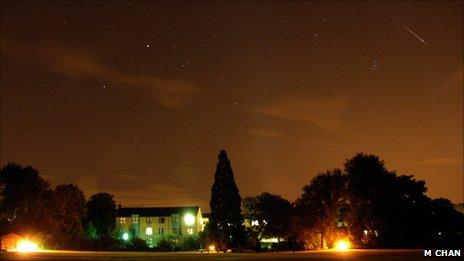Perseid meteor shower reaches second day of its peak
- Published

Many sky-watchers have photographed the meteor shower
Skywatchers across Europe have enjoyed another night of "fantastic views" as the annual Perseid meteor shower reached the second day of its peak.
The shower was expected to produce a display of up to 80 meteors per hour, according to Nasa.
"A waxing crescent moon will set before the shower becomes active, setting a perfect stage for meteor watching," said the US space agency.
Space enthusiasts in the UK and US have already captured images of the show.
John Mason from the British Astronomical Association told the BBC that the weather was helping those who wanted to view the shower.
"The shower has been ongoing for a week now and we have already seen some very bright meteors whizzing overhead," he said.
The Perseid meteor shower is caused by debris from the comet Swift-Tuttle.
Every 133 years, the huge comet swings through the inner part of our Solar System and leaves behind a trail of dust and gravel.
When Earth passes through the debris, specks hit our atmosphere at 140,000 mph (240,000 km/h) and disintegrate in flashes of light.
The Royal Astronomical Society said the relatively warm summer nights would make this meteor shower one of the more comfortable to watch.